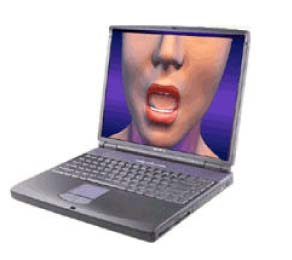"General solutions for the hard of hearing focused on improving
hearing, either by mechanical or surgical means. Since most hard of
hearing individuals rely on lip reading to help them understand the
spoken word, it was in this area where we sought a solution,"
explains Margalit in his company's office in Tel-Aviv.
Raising the level of lip reading is achieved by creating cued speech
which can be thought of as enhanced lip-reading -- signs are made
around the face that appear on the computer screen to provide vital
additional information about some of the phonemes being uttered.
Margalit points out that lip-reading is usually a practical means of
communication, but is not perfect-- typically, a person who is
lip-reading only recognizes 30 per cent of the words being uttered.
For example, b and p cannot be told apart -- and thus ``cued speech''
indicates which phoneme is being uttered. The enhancement of the
moving lips is achieved with algorithms, and in the final software,
allows for the deaf person to maintain, nearly seamlessly, a
conversation which begins with the speech of the caller and its
understanding by the handicapped person, as he visually reads the
conversation that has been converted into a lip readable format.
The software product trade named LipCcell, is installed in the
user's computer and connected with a cable to a cellphone. When the
deaf person receives a call, the software translates the voice on the
other side of the line into a three-dimensional animated face on the
computer, whose lips move in real time synch with the voice allowing
the receiver of the call to lip read.
Cellcom, Israel's largest mobile phone operator sensed a major
business opportunity and assumed sole distributorship for Israel. On
a global scale, there are 24 million hard of hearing individuals who
could be helped with LipCell. At $125 a set, the price would not seem
to be an obstacle.
 For severely partially or totally deaf people, lip-reading may be the
only possible means of everyday communication. Learning to lip-read
enables one to take part in everyday communication with family,
friends and colleagues, enabling participation and conversations
which one might previously have avoided. Lip-reading helps to
overcome the isolation which can all too easily result from a loss of
hearing. The technology which converts the spoken word such as is
used in the course of a telephone conversation has found application
in a new product offered by a young Israeli firm SpeechView Ltd. It
is a start-up founded in August 2000, after being incubated by
M-Insight, an Israeli based information technology company.
Three years ago Nachshon Margalit became interested in the field and
was startled when he realized that a project manager, whom he had
hired for his company, was hard of hearing. Though Margalit had
earned a doctorate in Information Technology, he had previously not
been faced with the challenge of aiding a person to overcome
deafness. That marked the beginning of an intensive research and
development effort, that led to the creation of software, which in
combination with a cell phone, allows hard of hearing or totally deaf
individuals, to carry on normal conversations.
For severely partially or totally deaf people, lip-reading may be the
only possible means of everyday communication. Learning to lip-read
enables one to take part in everyday communication with family,
friends and colleagues, enabling participation and conversations
which one might previously have avoided. Lip-reading helps to
overcome the isolation which can all too easily result from a loss of
hearing. The technology which converts the spoken word such as is
used in the course of a telephone conversation has found application
in a new product offered by a young Israeli firm SpeechView Ltd. It
is a start-up founded in August 2000, after being incubated by
M-Insight, an Israeli based information technology company.
Three years ago Nachshon Margalit became interested in the field and
was startled when he realized that a project manager, whom he had
hired for his company, was hard of hearing. Though Margalit had
earned a doctorate in Information Technology, he had previously not
been faced with the challenge of aiding a person to overcome
deafness. That marked the beginning of an intensive research and
development effort, that led to the creation of software, which in
combination with a cell phone, allows hard of hearing or totally deaf
individuals, to carry on normal conversations.